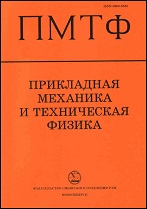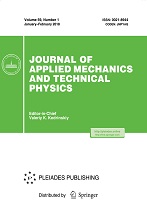|
This article is cited in 2 scientific papers (total in 2 papers)
Injection of a hydrate-forming gas into a snow block saturated with the same gas
V. Sh. Shagapovab, A. S. Chiglintsevaa, A. A. Rusinovc, M. K. Khasanovd, I. G. Khusainovd
a Mavlyutov Institute of Mechanics, Ufa Federal Research Center, Russian Academy of Sciences, Ufa, 450054, Russia
b Institute of Mechanics and Machinery, Kazan Scientific Center, Russian Academy of Sciences, Kazan, 420111, Russia
c Birsk Branch of Bashkir State University, Birsk, 452453, Russia
d Sterlitamak Branch of Bashkir State University, Sterlitamak, 453103, Russia
Abstract:
The problem of injection of a hydrate-forming gas (methane) into a snow block, whose pores in the initial state are saturated by the same gas. Self-similar solutions describing the temperature and pressure fields and the snow, hydrate, and gas distributions in the block are constructed. It is shown that three characteristic zones can be distinguished, depending on the initial thermobaric state of the snow-methane system and the rate of gas injection into the filtration region: a near zone, in which snow completely is converted into hydrate and, consequently, the hydrate layer is saturated with gas; an intermediate zone, in which gas, snow, and hydrate are in phase equilibrium; a far zone filled with gas and snow. It is shown that the length of the heated zone decreases with increasing initial snow content in the block and with decreasing injected gas pressure. It is also shown that the length of the region of hydrate formation increases with increasing permeability. It is also noted that the heating of the intermediate zone occurs more rapidly.
Keywords:
gas injection, filtration, snow block, self-similar solution, hydrate formation, volume region, Leibenson linearization.
Received: 27.06.2017
Revised: 04.09.2017
Citation:
V. Sh. Shagapov, A. S. Chiglintseva, A. A. Rusinov, M. K. Khasanov, I. G. Khusainov, “Injection of a hydrate-forming gas into a snow block saturated with the same gas”, Prikl. Mekh. Tekh. Fiz., 59:3 (2018), 43–56; J. Appl. Mech. Tech. Phys., 59:3 (2018), 422–433
Linking options:
https://www.mathnet.ru/eng/pmtf572 https://www.mathnet.ru/eng/pmtf/v59/i3/p43
|


| Statistics & downloads: |
| Abstract page: | 43 | | Full-text PDF : | 9 |
|





 Contact us:
Contact us: Terms of Use
Terms of Use
 Registration to the website
Registration to the website Logotypes
Logotypes








 Citation in format
Citation in format 
